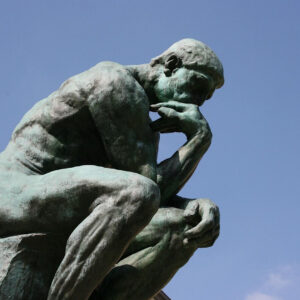In this essay, I would like to outline five stages along the spiritual path. These are intended to serve as a contextual map which I hope can help the aspirant make sense of the major issues he will face in his spiritual growth. In writing this, I risk exacerbating a common problem — the tendency of immature aspirants to judge their progress, and that of others, as though they were engaged in some athletic competition in which the goal is to cross the finish line as quickly as possible, and certainly before the other guy.
This competitive attitude, rooted in the ego’s desire for separation and status, is blind to two major aspects of the entire spiritual journey. First, spiritual evolution takes place within Nature’s manifestation and, therefore, proceeds at a pace in harmony with Nature herself. This organic process skips no steps, so advancement on the spiritual path is, in some ways, like physical maturation. It is not better to be 30 years-old than it is 15, though the older person will hopefully be addressing a more subtle set of life issues.
Second, the spiritual journey is entirely comprehensive. The journey begins with unity and ends with unity. The separate entity who wishes to advance beyond others is only delaying his own reunification with them. All consciousness is traveling through the cosmos as one. The individual entities are like waves on the same ocean. Large waves have more power than tiny waves, but their “superiority” is only on the surface. Both great and small are part of one magnificent body that ebbs and flows as one.
Stage 1: Shanti (Peace)
The first noble truth of the Buddha is sarvam duhkam, “all is suffering.” Some Buddhists say this means that the world is like a house on fire, within which we play like little children, unaware of our true situation. The house is our ego, our self-centered, separative identity. Like Midas, with his powerful but horrible touch, our ego-based identity brings suffering to every sphere of life that it contacts. Though this may sound drastic, the realization of the pervasiveness of suffering throughout the manifest universe is an important stage in spiritual growth.
For many Westerners, to say that all is suffering may sound somewhat pessimistic. We think this is how the world must look to somebody in a third-world country surrounded by poverty, starvation, and lack of television. But if we turn the coin around, we can see that our wealth and leisure actually keep us from probing the depth of the human condition. We are so busy with superficialities that we never glimpse below the tip of the iceberg of our small anxieties and worries, beneath which lay mammoth fears and terrors. The pleasures, entertainments, and distractions that our abundance permits can be seen as endless avoidance activities. For if we ever sat still, in silence, that creature from the depths of darkness that we so fear may have a chance to rise up and devour us.
When we do probe beneath the surface of superficial life, we find that the only thing worse than not getting what you want is getting what you want. For all selfish desires are but seeds of discontent. They sprout roots of separative consciousness and branches of competition. They flower in pride and produce the fruit of disappointment, within which are more seeds of discontent. The realization that all ego-based desire results in suffering brings forth the search for its opposite, shanti, peace. This longing for peace is the wisdom that begins to untangle the knot of ego.
Stage 2: Shakti (Energy)
In the quest for peace, the aspirant comes to the recognition that he will need great energy to accomplish all his life tasks without being overwhelmed and stressed-out. The aspirant is drawn to sadhanas which will improve his health and stabilize his emotions and mental framework. Experiments with diet, sleep, lifestyle, and various formal practices — such as visualization, pranayama (breath and energy work), and asana (physical exercises) — come into play in the pursuit of shakti.
During the search for shakti, one undergoes processes of purification. To maintain a state of high energy, the aspirant realizes that his body, emotions, and mind need to be pure and strong, capable of maintaining a high degree of energy. The ordinary person is like a low-wattage light bulb: channel too much electricity through the medium and the bulb will burn out. The aspirant seeks to make himself capable of holding high levels of shakti, that he might enjoy the divine luminance.
Purity of body means that the essentials of daily life must be met in a balanced manner. The Ayurvedic medical system, the sister science to yoga, states that there are three pillars of life: food, sex, and sleep. Food for an aspirant must be nourishing, fresh, and appropriate to the season and his lifestyle. A vegetarian diet is extremely helpful for many reasons, though one should not become fanatical about any aspect of diet. After all, it is only fuel for the physical vehicle; it should not become a means of distraction from the goal itself.
Sleep should be taken in moderation. One should sleep neither too much nor too little. As the body becomes healthy, less sleep is needed because the body is not stressed, and wasting the energy is obtained through food, water, air, and sunshine.
Sex, an activity that gives rise to great confusion and one too complicated to discuss in detail here, is not inherently a barrier to spiritual growth. Sexual activity, within the context of a consensual, mindful relationship, can be an avenue for the maturation of the personality and the satisfaction of the emotions. Sexual behavior, like eating and sleeping, is an issue of exercising moderation and using common sense.
The purity of the emotions and mind means that one must learn to remain positive and upbeat. One should look for the noble in all people and God’s will in all situations. One must cultivate attitudes of friendship and compassion towards all other beings. One must serve as an example of positive energy for those who are dispirited. This is not to imply that life is to be seen through rose-colored glasses. The aspirant should, however, strive to serve as a beacon of happiness in the night of depression and despair in which ego-based persons live. Being happy is amongst the greatest services one can provide for his brothers and sisters.
Stage 3: Ramlila (The Play of God)
As shakti develops, one feels powerful and confident. Life loses its burdensome nature and becomes worthwhile. The insight arises that one’s small life is in harmony with the great tides of God’s creation. And since God’s nature is joy, likewise does one begin to experience joy in his own life.
Spiritual exercises that were previously undertaken to obtain a goal, such as gaining shanti or shakti, are now done simply because they are enjoyable. At the early stages of sadhana, one feels like a child forced to do homework when he would rather play. The alarm clock rings in the morning and the beginning yogi wishes for nothing more than to roll over and go back to sleep. He does not understand why his teacher requires daily practice. He would prefer his sleep or coffee and newspaper to his morning sadhana.
Just as the child would rather play games than study, so would the immature yogi favor goofing-off to undertaking his practices. Later, however, like a student who has matured and becomes an enthusiastic scholar, the aspirant looks forward to those periods when he can focus on his spiritual practices. He no longer performs them because he seeks something further down his path, but because he finds gratification in his sadhana. Like an artist who enjoys painting or an athlete who delights in exercise, the yogi relishes the opportunity to express his creative life force through his sadhana.
Stage 4: Lankabhayankaram (Terrifier of Lanka)
With the acquisition of the vision of Ramlila, one might feel that his journey has reached completion. But this stage is only the prelude to full accomplishment. First, great obstacles that prevent permanent abidance in the sacred inner space must be overcome. From the very depths of the chitta (personal consciousness) arise fears, doubts, and defenses which are like a mighty wall obstructing further progress. In psychological terms, we might say that this is the appearance of the darker aspects of the subconscious which are resistant to change. They seek to remain the dominant forces in one’s psyche, reluctant to surrender before the tendencies of peace and harmony.
This insight has been presented mythologically in the tales of Christ being tempted in the desert, and of Buddha being tempted and attacked by Mara as he sat under the bodhi tree. In both cases the aspirant was victorious. Jesus put Satan behind him and went on to fulfill his mission. The Buddha persisted in his meditation until the forces of Mara were depleted, and he attained his supreme enlightenment dedicated to the welfare of all beings.
The term “lankabhayankaram” is an epithet given to Hanuman, one of the heroes of the great Indian epic, the Ramayana. It literally means “terrifier of Lanka,” as Hanuman is depicted as the destroyer of Lanka, the stronghold of demons. Hanuman is able to recognize a demon, no matter how subtle be his disguise, and he holds nothing back in his battle to destroy the negative forces. Symbolically, Hanuman (the accomplished aspirant) is able to recognize the demons (negative thoughts and feelings) which might present themselves to his consciousness, no matter how disguised (attractive, distracting, or logical) they might be. With his mighty club (the power of his own devotion) he destroys their presence in Lanka (in his heart).
Each aspirant must eventually find that fiery part of himself symbolized by Hanuman — selfless server and noble warrior. The spiritual path is not for the meek or those who give lip service to some amorphous, un-tested virtue described as “non-violence.” Gentleness towards others is always to be demonstrated, but one must be a mighty conqueror of the Lanka within. The demons of selfish desire and laziness will not surrender without a fight. They must be slain with the sword of vitality and enthusiasm for the battle!
Stage 5. Ma (Mother)
The primal human sound, Ma, universal throughout virtually every tongue, holds special significance in the yogic tradition. “Ma,” in Sanskrit, refers to the Great Goddess, the Divine Mother, the Alpha and Omega of existence. It is She who remains ever transcendent, yet permeates every atom of existence with Her loving presence. From Her, the One Absolute, arise the multitude of relative beings. She gives them birth and She nurtures their lives in the form of Mother Nature. She beguiles them with her veil of spiritual illusion, causing them to forget their divine status, while She also provides the props and supports they will need to become free of the illusion.
She laughs in divine intoxication at the blissful paradox of Her game. She is the peace that surpasseth understanding because she lives always beyond the known. She is never bound by any human concept or idea. In India, She is depicted as Kali, the dancing, black Goddess with a garland of human heads hung on her chest. For all people will be called to offer their heads (egos) to Her. They can do so lovingly, in devotion, after which they rise from their beheading reborn as Children of God. Or, if ignorance and pride prevent them from humbly submitting themselves to this process, Kali ends up with their heads anyway through the defeats that life heaves upon the egoic man — ending with the supreme defeat, the humiliation of death.
Yoga is a rational system of steps that lead to this fifth stage, the trans-rational leap of faith into that which can never be known, only loved. Depicting this Transcendent as Goddess is very appropriate for our time, for we have become estranged from nature and the feminine values of sympathy, tenderness, and an appreciation for the cyclical nature of life. Our rocket ships, our computers, and our atom bombs prove our ability to construct devices that demonstrate our cleverness at applying reason and manipulating Aristotelian logic. Great as these achievements might be, they leave us empty in the heart, for the heart is the realm of intuition. Like Adam and Eve, we have tasted the fruits of our knowledge, only to find how bitter is the cost.
I am not proposing that we abandon reason, only that it be informed by intuition. For unless we are able, when necessary, to leap from the knowing, defensive mind into the innocent, intuitive heart, our earthly accomplishments are nothing but dust. And, as our weapons of destruction suggest, we may end as dust if we don’t heed the voice of this inner Goddess. Bedecked with Her garland of severed heads, She appears dark and frightening only because she lives in the shadows of our unconscious. As one progresses through the stages of spiritual growth, one comes to know that fear of Her is nothing more than a self-perpetuating illusion based on ignorance.
Aspirant, fear nothing! Doubt your doubts, be angry with your anger, and penetrate through the darkness of terror-induced nightmares to the bliss-soaked dance of divine life: born, sustained, then destroyed by Ma.
Of Kali, Swami Vivekananda wrote,
Dancing mad with joy,
Come, Mother. Come!
For terror is Thy name,
Death is in Thy breath,
And every shaking step
destroys a world for e’er.
Thou ‘Time’, the All-Destroyer!
Come, O’ Mother. Come!
Who dares misery love,
And hug the form of Death,
Dance in destruction’s dance,
To him, the Mother comes.




